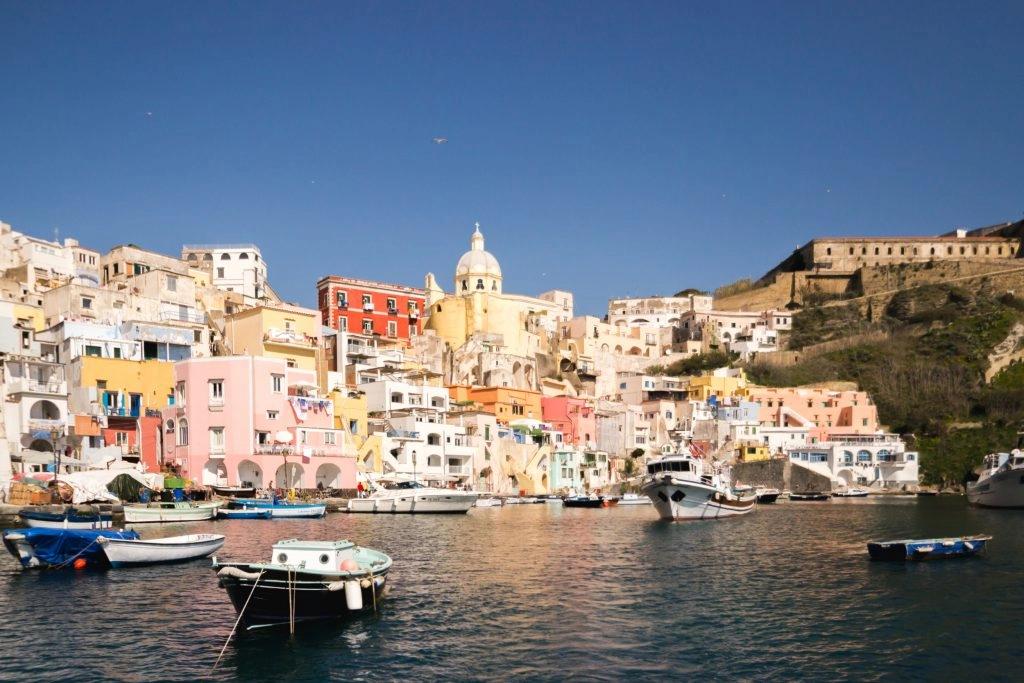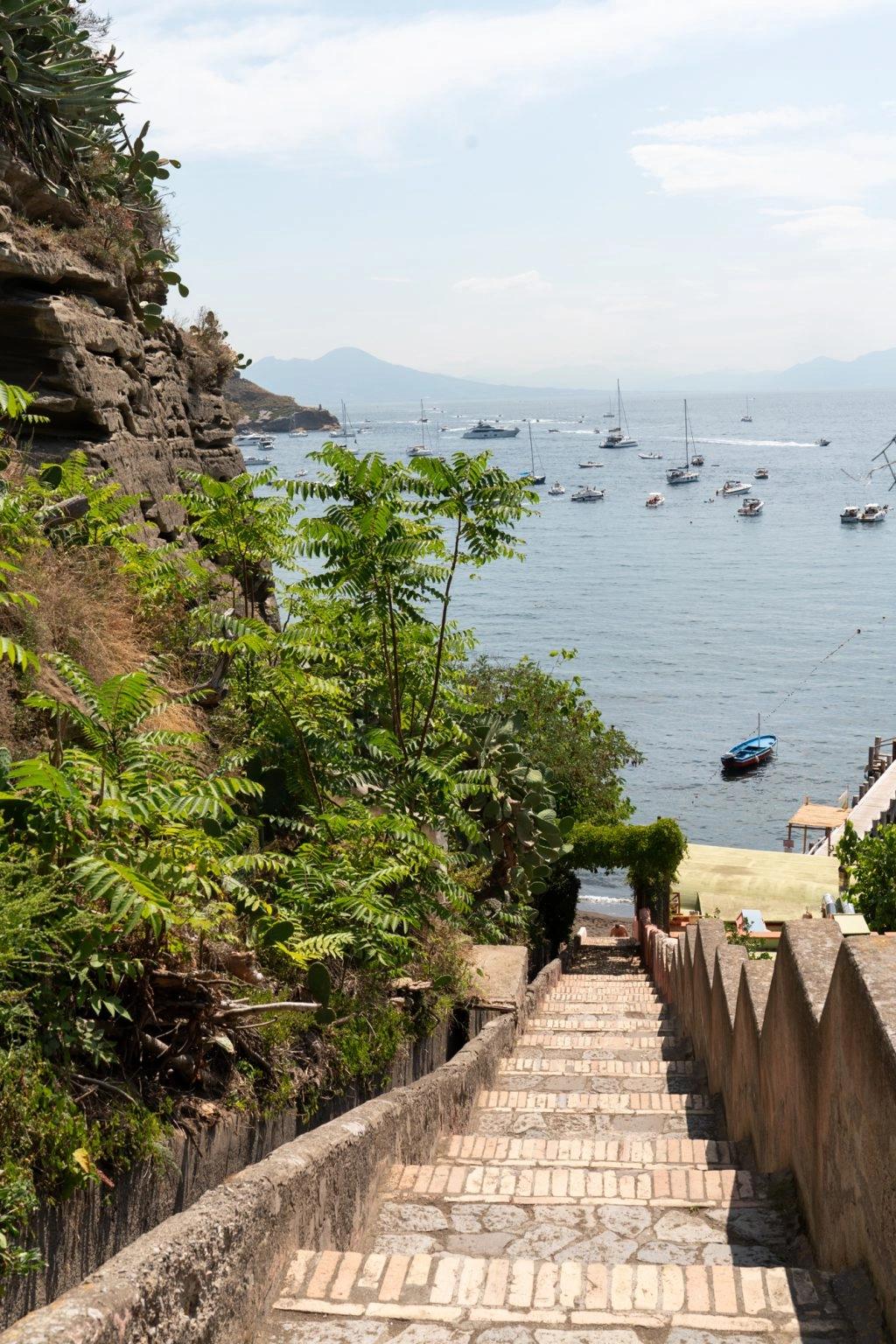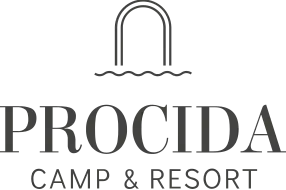May 3, 2021
Procida what to see and what to do
“Ed ecco la sorpresa. Un allineamento di case di tutti i colori, strette come una barricata, con tante arcate chiuse a mezzo, come strizzassero un occhio. E sopra un verde intenso, prepotente, quasi selvaggio, tanta è la forza dei getti e dei tralci: viti e limoni.”(Cesare Brandi da Terre d’Italia, Bompiani, Milano, 2006, p. 467)

With its 4km square of alleys and ups and downs, Procida is made to be explored slowly, on foot or by bicycle. As its inhabitants say, either you hate it or you love it: if you are looking for entertainment and social life, this is not the right place. Procida is crowded but only by its inhabitants, and it seems to have stood still over time. Here you will be greeted by a sunny and wild atmosphere, by an unmistakable architecture that tells an ancient and fascinating story, by narrow streets that suddenly open onto breath-taking views, by authentic and genuine flavours. The silence, the wind, the sound of the sea breaking on the rocks, the scent of lemons, the sunny cheerfulness of its inhabitants. This is the Procida that we like to share.
Terra Murata
Terra Murata is the oldest inhabited centre on the island, dating back to the medieval period. Its name derives from the fortified walls, built to defend the population from the continuous incursions of the barbarians. It is the highest point on the island, but the spectacular view of the Gulf of Naples and Corricella fully repays the effort of the climb.
Along the road to reach Terra Murata you can see the church of the Madonna delle Grazie, which with its rounded dome is certainly one of the most photographed places on the island.
Palazzo d’Avalos
Arriving at the top of the hill of the Castle, between the narrow alleys and the houses leaning against each other, the Palazzo d’Avalos rises imposingly, a Renaissance building built as a noble residence and later transformed into a penitential prison.
The prison was closed in 1986, was partially renovated and is now open to visitors. Walking through its rooms is a journey through time: along the way there are still old registers and newspapers, looms and ancient sewing machines, worn uniforms and boots, and the marks left by the prisoners in their cells. The remains of the van that transported the detainees are also visible, mentioned in the work of Elsa Morante “L’isola di Arturo”.

Marina Grande
This is the beating heart of the island. Here the ferries and hydrofoils arrive, the climate is hectic, you can smell the scents of the pastry shops in via Roma that churn out the famous lemon-stuffed cat tongues. It is pleasant to get lost among local craft shops, bars and restaurants. In the afternoon, on the other hand, you can buy fresh fish directly from the fishing boats.
What to see in Marina Grande?
- The Palazzo di Montefusco: located a few steps from the dock, it is recognized by the characteristic battlements. It was once the king’s summer residence
- the church of Santa Maria della Pietà: it can be found along the main street (via Roma) towards Piazzetta Sent’Co.
- the wooden crucifix, erected by sailors in 1845, is one of the many religious symbols that can be found around the island.

La Corricella
Strolling around Corricella is like entering in a watercolour painting, where the shapes blend delicately with the sea water.
It is the oldest fishing village on the island, and here you can fully breathe the atmosphere of a fishing village, among the nets curled up on the quay and the clothes hanging in the sun. The rough appearance of Procida in this neighborhood gives way to a cheerful and relaxed atmosphere, a small oasis of peace thanks also to the absence of cars. In fact, here you can only access on foot, through one of the 4 steps that descend between the houses, or by sea.
The architecture of the village offers that postcard landscape which is Procida’s calling card known all over the world. The houses perched on the coast share stairs and balconies, giving the impression of being clinging to each other, and are characterized by the vefio, the typical arched balcony. This place is so particular and suggestive that it is no coincidence that it was chosen as the film set for the film Il Postino by Massimo Troisi, with Maria Grazia Cucinotta. It is the ideal place to savour a little of that “dolce vita” so typical for southern Italy.

Vivara
The island of Vivara is connected to Procida by a long Tibetan bridge that starts from the promontory of Santa Margherita, on the southern part of the island. Vivara is what remains of an ancient volcanic crater and has a naturalistic heritage of the highest value.
Since 2002 it has been a state nature reserve and is part of the Kingdom of Neptune Marine Protected Area. Why is it worth a visit?
- there are 32 hectares of thick and fragrant Mediterranean vegetation, with some rare species
- it is inhabited by free and wild fauna, including many species of birds that find a safe and almost untouched refuge on the island
- it is an oasis of peace and silence, where you can let yourself be intoxicated by the scent of salt and wild myrtle
- you can admire a landscape of unparalleled beauty from the King’s table, a panoramic point that offers an extraordinary view of the entire Gulf of Naples. From here you can see the Aragonese Castle of Ischia and, in the distance, the island of Capri.
- you will discover anecdotes and curiosities about this island and its history, told by expert naturalist guides.
The island of Vivara can only be visited at weekends, with a guided tour and obligatory reservation. Read more about it here.

Beaches
Procida is history, architecture, good food and of course… the sea!
There are many beaches that extend along the 16 km of Procida coast; most can be reached on foot, by bike or by city bus.
In Procida there are some of the most beautiful beaches of the Campania coast. The sand is dark, because of volcanic origin, in some areas it is finer in others grainier. The northern most tip of the island, on the other hand, is rocky and wild, but offers truly beautiful bays and ravines.
The most popular beaches in Procida are undoubtedly Ciraccio and Chiaolella, but also Chiaia which is accessible via a narrow staircase set between rocks and vegetation.
Some small beaches, inlets and bays can only be reached by sea and it will be magical to discover them by renting a dinghy.
Among these, the Chiaia dell’Asino, which is located just below the palace of Avalos and was once the only access route to the former prison.
Or the beach of Punto Ottimo, small and wild, hidden in a rocky inlet not far from the most famous Postino beach.
Procida’s beaches are suitable for everyone and everyone can find the one that best suits their needs: snorkelling, sunbathing on the sand or rocks, diving or enjoying a little relaxation while the children play safely. Almost everywhere you can rent sunbeds and umbrellas, and enjoy a cold drink or a light lunch in one of the many kiosks and restaurants.
Have you already fallen in love with this small island near Naples? Live a unique experience by staying at Procida Camp and Resort!

Footer
Mille Immobili s.r.l.
Via Santa Brigida 51
80133 Napoli (NA)
Tel. 0818101112
P.Iva: 02360120600
ㅤ
CIN La Caravella IT063061B2RBTWOJJ2
CIN Ciraccio IT063061B3HAZG59H4
ㅤ
